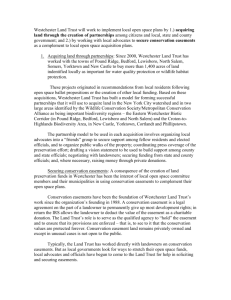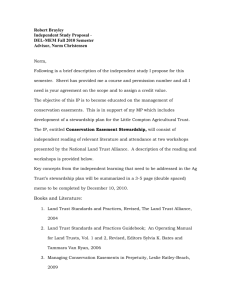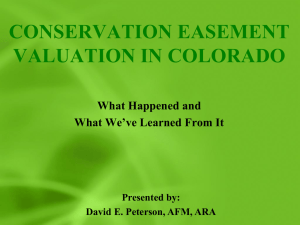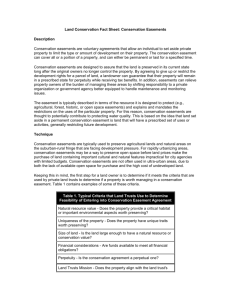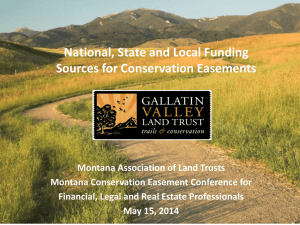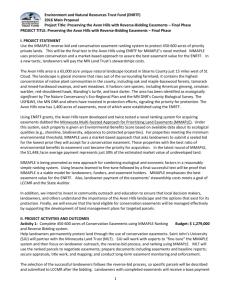Monitoring Municipal Open Space & Conservation Easements
advertisement
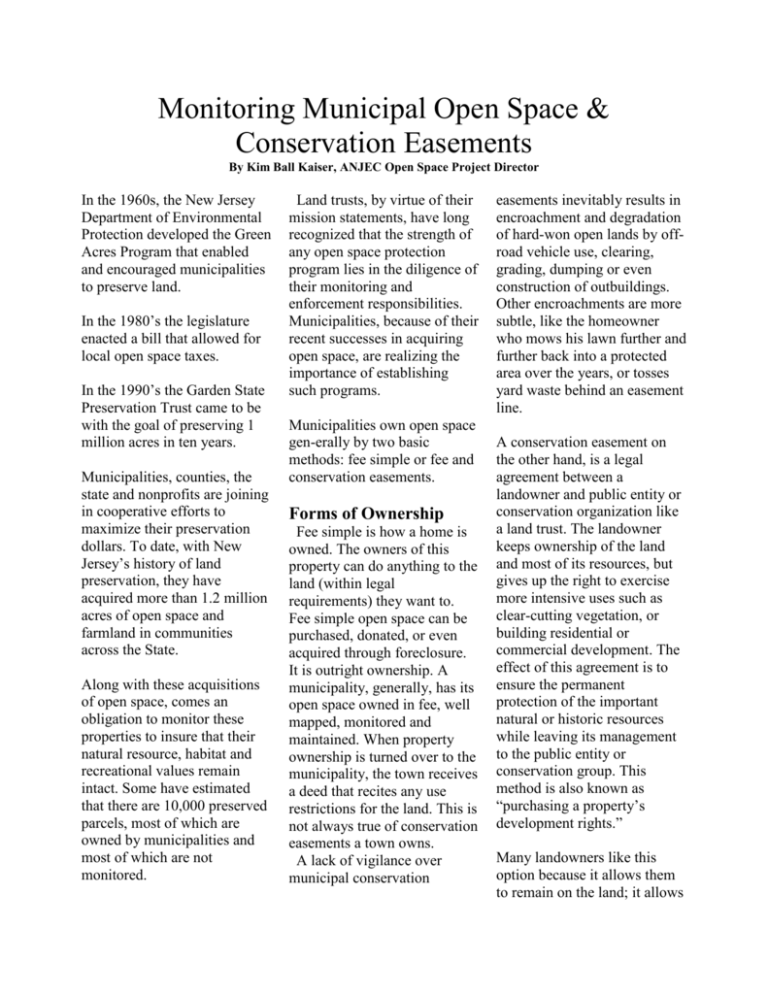
Monitoring Municipal Open Space & Conservation Easements By Kim Ball Kaiser, ANJEC Open Space Project Director In the 1960s, the New Jersey Department of Environmental Protection developed the Green Acres Program that enabled and encouraged municipalities to preserve land. In the 1980’s the legislature enacted a bill that allowed for local open space taxes. In the 1990’s the Garden State Preservation Trust came to be with the goal of preserving 1 million acres in ten years. Municipalities, counties, the state and nonprofits are joining in cooperative efforts to maximize their preservation dollars. To date, with New Jersey’s history of land preservation, they have acquired more than 1.2 million acres of open space and farmland in communities across the State. Along with these acquisitions of open space, comes an obligation to monitor these properties to insure that their natural resource, habitat and recreational values remain intact. Some have estimated that there are 10,000 preserved parcels, most of which are owned by municipalities and most of which are not monitored. Land trusts, by virtue of their mission statements, have long recognized that the strength of any open space protection program lies in the diligence of their monitoring and enforcement responsibilities. Municipalities, because of their recent successes in acquiring open space, are realizing the importance of establishing such programs. Municipalities own open space gen-erally by two basic methods: fee simple or fee and conservation easements. Forms of Ownership Fee simple is how a home is owned. The owners of this property can do anything to the land (within legal requirements) they want to. Fee simple open space can be purchased, donated, or even acquired through foreclosure. It is outright ownership. A municipality, generally, has its open space owned in fee, well mapped, monitored and maintained. When property ownership is turned over to the municipality, the town receives a deed that recites any use restrictions for the land. This is not always true of conservation easements a town owns. A lack of vigilance over municipal conservation easements inevitably results in encroachment and degradation of hard-won open lands by offroad vehicle use, clearing, grading, dumping or even construction of outbuildings. Other encroachments are more subtle, like the homeowner who mows his lawn further and further back into a protected area over the years, or tosses yard waste behind an easement line. A conservation easement on the other hand, is a legal agreement between a landowner and public entity or conservation organization like a land trust. The landowner keeps ownership of the land and most of its resources, but gives up the right to exercise more intensive uses such as clear-cutting vegetation, or building residential or commercial development. The effect of this agreement is to ensure the permanent protection of the important natural or historic resources while leaving its management to the public entity or conservation group. This method is also known as “purchasing a property’s development rights.” Many landowners like this option because it allows them to remain on the land; it allows for preservation of land when an owner is reluctant to vacate the premises. Many towns also like this approach because acquiring a conservation easement is less costly than buying property in fee simple. The Role of Environmental Commissions There are generally three scenarios when a municipality takes a conservation easement: when a resident voluntarily donates or sells an ease ment on appropriate land; during the subdivision or site plan process when municipalities require applicants to give conservation easements, for instance on wetlands, steep slopes over 25 or 30 percent or stream protection corridors; or when a municipality asks for an easement on elements like historic hedgerows or tree lines. So who in a municipality would be appropriate to identify municipal conservation easements and setup a pro-gram to monitor and maintain them? State enabling legislation and local ordinances give environmental commissions the responsibility to advise municipal government on environmental resource planning and protection issues. They have broad advisory powers that enable them to perform a variety of activities in their communities. Although environmental commissions have no enforcement powers they can serve the municipality as monitors for environmental protection. Not only can they assess development impacts, they can also inspect open space and easements and keep complete records on them. Finding and Mapping Open Space & Conservation Easements Developing a comprehensive inventory of existing public open space is a good place to start. Does the town have a Recreation and Open Space Inventory (ROSI)? Any town that applies for Green Acres funds has to prepare a ROSI which lists by block and lot, all municipally-owned land held for conservation or recreation purposes, whether purchased with Green Acres money or not. This includes the purchase or acquisition of conservation easements. Other places to look for information are in the town’s Open Space and Recreation Plan put together for Green Acres applications, or an open space or greenway element in your master plan. Local tax maps may have conservation easements noted on them. Additionally, some counties have done some digital mapping work that may include conservation easement information. But what if none of this information is available? The township’s planning department keeps plats of all the development in town; the municipality should have a copy of every site plan and subdivision plan in the township. These plans indicate where the conservation easements are located with a dash line. It’s a daunting prospect, but it is a tried and tested method for capturing data on conservation easements. Once you find out where the property is, get a copy of the deed and conservation easement language. There could be restrictive language in the deed with regard to township owned property. The same is true with easements…to know what the restrictions are, what activities are permitted on the land. Easement language is not uniform. Years ago conservation easements were one page long, now some go on for 30 pages. You also need to check the metes and bounds description in the deed to establish the parameters of the easement. With luck, the local tax office may retain a copy of the deeds for land or easements the town owns. However you may ultimately have to go to the county clerk’s office where all deeds are recorded. To find the deed you need block and lot information (available from the tax map or the plats). Once the conservation easements have been identified, develop a computer database, with block and lot numbers, owner, easement holder, easement terms, significant environmental features, chronology of monitoring visits, etc. Dated photographs of the lands under easement are a good way to document the status of the property. Next develop a baseline documentation checklist and a monitoring inspection form to record changes (written and photographic) since the last visit; then inspect each easement annually (ideally) with advance notice given to the landowner and with the owner present. Finally good record keeping and storage is vital. The data needs to be available for future generations and to provide continuity for new stewards. Next Steps In addition to establishing a conservation easement monitoring program, an environmental commission can pursue several programs to preserve the key resources of protected open space. First and foremost is public education. Place an article in the town newsletter or local newspaper on conservation easements, their importance to habitat and natural systems and the usual activities restricted by them. Have a public meeting, get a speaker. Place data on the ‘care and feeding’ of easements on the town or commission website. Hand in hand with public education is landowner outreach. Invite owners of land with easements to Saturday morning coffee and doughnuts at town hall to discuss the importance of conservation easements and monitoring. Develop a brochure and mail it to owners. Some municipalities have enacted ordinances that require conservation easement markers be placed on all new conservation easements created during the site plan subdivision process. One town requires a notice be sent when property with an easement changes hands, so that the new owners know about the conservation easement. The key to the enforcement of easement provisions is education, regular, well-documented inspections and a congenial partnership with the landowner. Copies of forms other organizations use for monitoring are available at ANJEC. A number of environmental commissions in Morris County have begun to tighten up their easement tracking systems. Washington Township now enters all easements onto the municipal tax map, and requires physical markers along the perimeter of protected lands. Over the last several years, the Harding Township commission inventoried municipal conservation easements, a tedious process that involves searching through deeds and planning board resolutions. Commission members worked with local volunteers to walk and photograph the lands under easement, creating a database that will serve as a baseline for monitoring. The Chatham Township commission recently completed an inventory of municipal conservation and trail easements, and converted the easement information into GIS (computerized) format for inclusion on the town’s computerized block and lot tax map. The commission set up a website http://www.geocities.com/ctecnj that provides conservation easement information for landowners, including a spreadsheet of the township’s easement inventory
